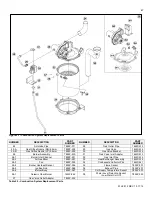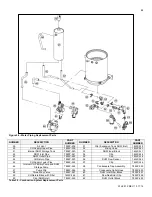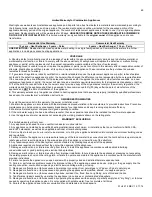
55
WHL-012 REV. 12.17.14
D. PURGE AIR FROM CH AND INTERNAL STORAGE TANK
IMPORTANT!
While commissioning the system, the air vent on top of the appliance must remain fully open to allow the appliance to
properly fill. Failure to keep the air vent open could lead to improper appliance and system operation.
To purge air from the system:
a. Connect a hose to the purge valve and route hose to an area where water can drain and be seen.
b. Close the appliance or system isolation valve between the purge valve and fill connection to the system.
c. Close zone isolation valves.
d. Open quick-fill valve on cold water make-up line.
e. Open purge valve.
f. Open the isolation valves one zone at a time. Allow water to run through the zone, pushing out the air. Run water until no
noticeable air flow is present. Close the zone isolation valves and proceed with the next zone. Follow this procedure until all
zones are purged.
g. Close the quick-fill water valve and purge valve and remove the hose. Open all isolation valves. Watch the system pressure
rise to correct cold-fill pressure. It is recommended that you put the pumps into manual operation to assist in purging the
circuits.
h. Disconnect the wires that are connected to the THERMOSTAT terminals of the terminal block. Apply power to the
appliance. After the control goes through the start-up sequence, the display will turn off.
i. Press and hold the
button for five seconds. Then scroll to 29:AP by turning the dial
. Press the
button. AP:cP will
show on the display. Press the
button to change the test time. The default is five minutes. Turn the dial
counterclockwise to lower or clockwise to raise the displayed value. Press the
button again to save any changes.
j. Then use the dial
to scroll to cP:off. Press the
button to turn on test mode. Turn the dial
counterclockwise to
lower or clockwise to select on. Press the
button again to start test mode.
k. The CH and internal circulation pumps will come on. Run pumps as required to help bleed out all entrapped air. Some good
indicators that air is removed include the absence of gurgling noises in the pipes and pump operation becoming very quiet.
Test mode will stop automatically after the set time (default is five minutes), or press the
button to leave it manually.
l. After the system has operated for some time, eliminate any residual air by using the manual air vents located throughout the
system.
m. If purge valves are not installed in the system, open manual air vents in the system one at a time, beginning with the lowest
floor. Close vent when water squirts out. Repeat with remaining vents.
n. Refill to correct pressure.
E. PURGE AIR FROM DHW SYSTEM
1. Make sure CH and DHW lines to the appliance are open and full of water. Turn on all electric power to appliance.
Ensure the appliance is full of water before firing the burner. Failure to do so will damage the appliance. Such damage IS NOT covered
by warranty, and could result in property damage, serious personal injury, or death.
2. Open hot water faucets in the DHW system. Start with the faucets nearest the appliance.
3. Keep faucets open until water runs freely and all air is purged. Then move on to faucets further away from the appliance in the
system.
4. When water flows freely from all hot water faucets, DHW purging is complete.
F. CHECK THERMOSTAT CIRCUIT(S)
1. Disconnect the two external wires connected to the appliance thermostat terminals (low voltage terminal strip).
2. Connect a voltmeter across these two incoming wires with power supplied to the thermostat circuits. Close each thermostat, zone
valve and relay in the external circuit one at a time and check the voltmeter reading across the incoming wires.
3. There should NEVER be a voltage reading.
4. If a voltage reading does occur under any condition, check and correct the external wiring. (This is a common problem when using 3-
wire zone valves.)
5. Once the external thermostat circuit wiring is checked and corrected if necessary, reconnect the external thermostat circuit wires to
the appliance low voltage terminal strip. Allow the appliance to cycle.
Summary of Contents for WBRCLP140F
Page 2: ...2 WHL 012 REV 12 17 14 ...
Page 38: ...38 WHL 012 REV 12 17 14 Figure 26 Electrical Wiring Diagram ...
Page 39: ...39 WHL 012 REV 12 17 14 Figure 27 Ladder Diagram ...
Page 73: ...73 WHL 012 REV 12 17 14 ...
Page 74: ...74 WHL 012 REV 12 17 14 ...
















































